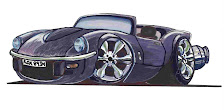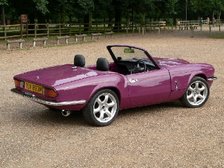Time for Plan B, I had picked up a diaphragm type PCV valve, only problem was finding somewhere to fit it, no room on top of the intake manifolds.
After some pondering, decided to use my redundant distributor mounting, This needed a bit of machining to make it suitable, I also added a fixing point to hold the valve in place.
 Not sure where I originally picked up this valve.
Not sure where I originally picked up this valve. The valve pushes into the modified distributor housing and is held in with a small cap head bolt.
The valve pushes into the modified distributor housing and is held in with a small cap head bolt. Fits quite neatly on the side of the block
Fits quite neatly on the side of the block Plumbed into the intakes via some 1/2" tubing pressed into the end of the manifolds.
Plumbed into the intakes via some 1/2" tubing pressed into the end of the manifolds.
Checked everything was fitted ok and started the engine, my pressure gauge was showing a 15 mbar depression at idle. Took it out for a drive, subjecting it to various operating conditions, the valve seemed to pretty much maintain a constant 15 mbar depression +/- 10 mbar. The original engine breather is now the fresh air into the engine crankcase and is fitted with a small restrictor to create the depression. With no restrictor it would be like having an air leak post throttle in the intake system.
 Alloy hubs with larger stub axle and improved bearings.
Alloy hubs with larger stub axle and improved bearings.
 And a very nice pair of AP Racing calipers, couldn't believe how light these calipers are, a friend has promised to get me a set of decent pads, they should arrive over Christmas.
And a very nice pair of AP Racing calipers, couldn't believe how light these calipers are, a friend has promised to get me a set of decent pads, they should arrive over Christmas.








 I used some aftermarket seat runners as the seats I bought didn't have any, the inner runner needs to be modified to match the seat pan. On my setup I used the original MX5 seat mounting points on the outer runner and the front fixing on the inner runner, I welded in a nut for the rear fixing on the inner runner.
I used some aftermarket seat runners as the seats I bought didn't have any, the inner runner needs to be modified to match the seat pan. On my setup I used the original MX5 seat mounting points on the outer runner and the front fixing on the inner runner, I welded in a nut for the rear fixing on the inner runner. I used Securon seat belts with short steel stalks and bolted these directly to the seat in place of the MX5 seat belt stalk. There are slight differences between the driver and passenger seat but you basically make the same modifications.
I used Securon seat belts with short steel stalks and bolted these directly to the seat in place of the MX5 seat belt stalk. There are slight differences between the driver and passenger seat but you basically make the same modifications.


